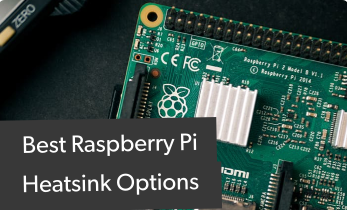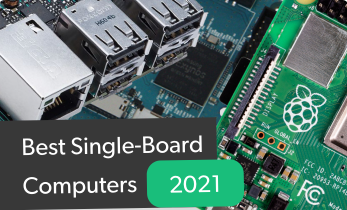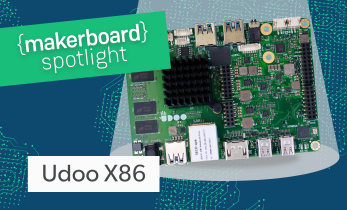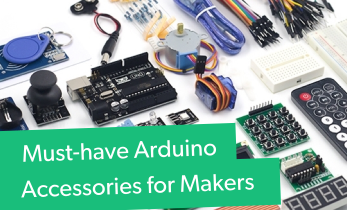Most Powerful Single Board Computer
There are all sorts of single-board computers (SBCs) on the market. From budget-priced, tiny maker boards suited to Internet of Things (IoT) and wearable device use, to development boards for robotics, home server purposes, and retro gaming, SBCs are truly multi-purpose. Thanks to technological advancements, smaller PCs with higher processing power are available. Check out the most powerful single board computer options you can find!
What is a Single-Board Computer?
As its name suggests, a single-board computer is a PC where all components come baked into the board. Typically, SBCs boast small form factors, such as the credit card-sized Raspberry Pi and other Pi alternatives. Other times, dev boards come in somewhat larger sizes, but on the whole the footprint of the average SBC is smaller than most standard desktops.
Onboard, single-board computers feature a CPU (central processing unit), GPU (graphics processing unit), RAM, and a slew of other components. As such, SBCs let you simply add an operating system (OS), often installed on a microSD card or eMMC module.
What is a single-board computer: A small-footprint PC that comes with all components (RAM, CPU, GPU) baked in, just add an OS.
What to Look for When finding the Most Powerful SBC
So what should you search for when selecting the most powerful single-board computer on the market? This somewhat depends on your use case. For processing power, you'll want to consider CPU power, GPU power, or both. Purposes such as gaming and artificial intelligence (AI) processing require both beefy CPUs and GPUs. A media server or file server will rely more on the CPU, as will emulation. And sometimes, you'll require both a strong CPU and GPU. Aside from pure CPU power, decide if you need an ARM SBC or x86 single board computer. This will directly impact the types of operating systems and apps that you can run.
RAM may be a consideration as well, particularly since you usually can't upgrade RAM on many dev boards. If you require a lot of multi-tasking capabilities, think about your memory requirements. Consider your size requirements. Largely, SBCs come in compact form factors. However, some are credit card-sized whereas others are somewhat bigger. Compatible operating systems is a huge factor. And think about connectivity such as Wi-Fi, Bluetooth, Ethernet, and any ports such as HDMI, I2C, and GPIO.
Powerful SBC considerations:
- CPU
- GPU
- ARM vs x86
- RAM
- Connectivity (Wi-Fi, Bluetooth, HDMI, I2C, GPIO, etc.)
- Size
- Cost
- OS compatibility
Most Powerful Single-Board Computer Overall - UDOO Bolt V8
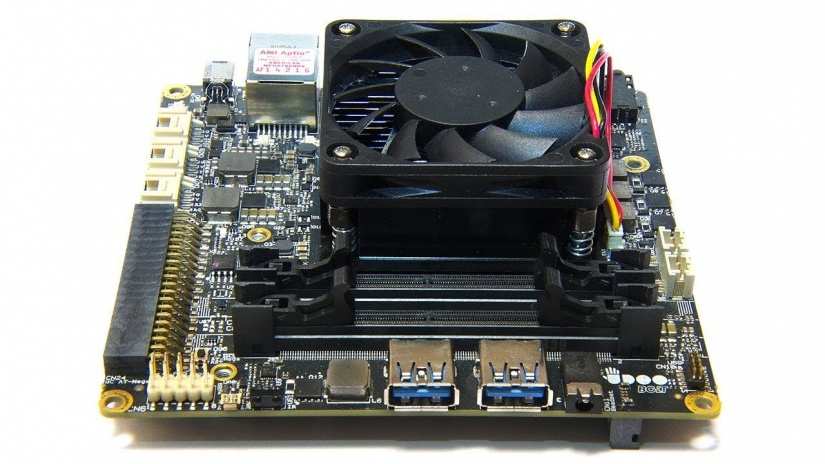
The UDOO Bolt is capable of handling virtually anything you throw at it. Boasting AMD Ryzen Embedded V1000 system-on-a-chip (SoC), the UDOO Bolt is a beast of a single-board computer. Because of its ultra-powerful AMD Ryzen APU, the Bolt can handle AAA PC gaming, retro gaming emulation, video editing and 3D design, AI applications, and even cryptocurrency mining. It's a beefy little device in an ultra-small form factor.
There are two different versions of the UDOO Bolt, the V8 and V3. While the UDOO Bolt V3 rocks an AMD Ryzen Embedded V1202B dual-core four-thread @2.3Ghz processor. Compare that to the Bolt V8 with its AMD Ryzen Embedded V1605B quad-core eight-thread @2GHz processor. Both boards feature dual SO-DIMM RAM slots with 64-bit DDR4 2400 RAM support up to 32GB. The UDOO Bolt V3 sports Vega 3 AMD graphics with its V8 counterpart rocks a Vega 8 processor. Unlike many other dev boards, the UDOO Bolt does have upgradeable RAM. What's more, it's x86-based so you can run Windows 10 and many full-fledged desktop Linux distributions on the Bolt. It's a bit expensive at over $300 USD. Still, for the price you get an incredibly competent SBC. When contrasted with $50 and under maker boards such as the Raspberry Pi, that cost seems astronomically high and outrageous. Still, as a desktop-caliber machine, the UDOO Bolt is a monster SBC.
Pros:
- Powerful CPU and GPU
- x86 SBC can run Windows 10 and x86 Linux OSes
- AMD Ryzen Embedded V1000 chip with Vega 8 graphics (or Vega 3 with the UDOO Bolt V3)
- Excellent connectivity
- Up to 16GB of DDR4 RAM
- Can handle GPU- and CPU-intensive tasks including retro gaming emulation, AAA gaming, VR, and AI
Cons:
- Pricer
- Larger than most SBCs like the Raspberry Pi
Udoo Bolt specs:
- AMD Ryzen Embedded V1000 with Microchip Atmega32U4 MCU: V1202B — 2x (4x thread) Ryzen cores @ 2.3GHz/3.2GHz boost with Radeon Vega 3, or Microchip Atmega32U4 MCU V1605B quad-core, (8x thread) Ryzen cores @ 2.0GHz/3.6GHz boost with Radeon Vega 8 graphics
- Memory/storage: 0GB, 4GB, 8GB, or 16GB DDR4-2400 RAM with ECC support via 2x sockets (supports up to 32GB)
- 32GB eMMC 5.0
- M.2 B-Key 2260 for SSDs (also supports PCIe x2)
- M.2 M-Key 2280 for NVME storage modules (also supports PCIe Gen 3 x4)
- SATA III connector with SATA power
- 802.11ac and Bluetooth 4.0
- Gigabit Ethernet port
- Dual HDMI 2.0a ports, dual DisplayPorts available through dual-role USB 3.0 Type-C ports
- 4 x simultaneous 4K@60 displays
- Radeon Vega 3 or 8 graphics with DirectX 12, OpenGL, and Vulkan support; H.265 decode and (8-bit) encode, VP9 decode
- Headphone/mic combo jack
- 2 x USB 3.1 ports
- 2 x USB 3.0 Type-C
- Arduino-compatible MCU I/O: Up to 26x digital I/O (includes up to 7x PWM)
Most Powerful Intel Single-Board Computer - Nvidia Xavier NX
Nvidia might be a household name because of their gamer-oriented GPUs as well as consumer streaming boxes like the Nvidia Shield TV. However, Nvidia offers a slew of hardcore devices for maker and tech enthusiasts including its AI-capable GPUs. And the Nvidia Xavier NX is a superb development board. As one of the top most powerful single-board PCs on the planet, the Nvidia Jetson NX is branded the world's smallest AI supercomputer.
Indeed, the Jetson NX pairs its 6-core NVIDIA Carmel 65-bit ARM V8.2 @1400MHz CPU with a beefy 384-core NVIDIA Volta clocked at 1100MHz. Packing 48 Tensor cores and dual NVIDIA Deep Learning Accelerator (NVDLA) engines, the Jetson Nano is an artificial intelligence-capable SBC. What's more, its impressive hardware is capable of handling 4K video output as well as retro gaming emulation and even AAA PC gaming. Blurring the lines between single-board computer and desktop, the Nvidia Jetson NX is a solid little device. You might also consider the Nvidia Jetson Nano which is similar to the Jetson NX but opts for a passive rather than an active heatsink. Additionally, the NX introduces more CPU cores, a higher clock rate, and more as well as faster RAM. Accordingly, while the Nvidia Jetson Nano and NX are both AI-ready, the NX yields drastically improved performance for artificial intelligence making such as Deep Learning, image processing, facial recognition, and even self-driving cars. There's even a robotics kit for the Nvidia Jetson for creating an autonomous vehicle.
Pros:
- AI-capable - can handle machine learning, natural language processing, and other artificial intelligence applications
- Great for robotics making
- Good for desktop use
- Able to tackle high-end retro gaming emulation (PS3, Wii, Wii U, PS2)
- Excellent I/O - Wi-Fi, Bluetooth, USB 3.1, GPIO, HDMI/DisplayPort
- Up to 21 TOPS of computer power
- 4K video output
- Compact footprint when compared to most desktops
Cons:
- Pricey
- Bigger footprint than the average single-board computer like the Raspberry Pi
Nvidia Jetson Xavier NX specs:
- CPU: 6-core NVIDIA Carmel 64-bit ARMv8.2 @ 1400MHz* (6MB L2 + 4MB L3)
- GPU: 384-core NVIDIA Volta @ 1100MHz with 48 Tensor Cores
- Dual NVIDIA Deep Learning Accelerator (NVDLA) engines
- 8GB 128-bit LPDDR4x @ 1600MHz | 51.2GB/s
- 16GB eMMC
- 2 x DisplayPort 1.4, eDP 1.4, HDMI 2.0 @4Kp60
- 10/100/1000 BASE-T Ethernet
- USB 3.1, 3 x USB 2.0
Best x86 Single Board Computer - Seeed ODYSSEY X86J4105800
While many SBCs are ARM-based, an x86 single-board computer touts loads of benefits. The Seeed Odyssey X86J4105, as its model number alludes, it sn x86 SBC. As such, its CPU can handle a vast array of different operating systems including Windows 10 and desktop Linux distros like Ubuntu, Arch Linux, Linux Mint, Manjaro, and Pop!_OS. Connectivity is superb with the usual trappings of a maker board such as Wi-Fi, Ethernet, and even onboard GPIO pins plus an Arduino controller. Pairing desktop PC features with maker board elements all in an x86 CPU-powered package makes the Odyssey X86J4105 a fantastic option that further deconstructs the barriers between desktops and SBCs. At just under $300, the x86 mini PC isn't cheap. Still, it's well-specced out and remains one of the greatest Intel single-board computers that money can buy.
Yet, the Odyssey X86J4105 isn't without its caveats. As Tom's Hardware reports in their review, the Raspberry Pi-compatible GPIO header fails to function properly with certain Raspberry Pi add-ons. Moreover, the CPU fan doesn't work correctly out-of-the-box. Nevertheless, at a bit less than $300, the Seeed Odyssey X86J4105 is a fantastic, powerful maker board.
Pros:
- Powerful CPU
- Excellent connectivity
- Arduino co-processor built-in
- Intel Celeron CPU
- Runs Windows 10 and x86 Linux distros
Cons:
- Only Intel HD integrated graphics chip
- Expensive
Odyssey X86J4105800 specs:
- CPU: Intel Celeron J4105 @ @ 1.5–2.5GHz
- GPU: Intel UHD Graphics 600 @ 250–750MHz
- Co-processor Microchip ATSAMD21G18 32-Bit ARM-Cortex M0+
- LPDDR4 8GB
- Wi-Fi
- Bluetooth
- 64Gb eMMC (optional)
Most Powerful SBC on a Budget - Rock Pi 4
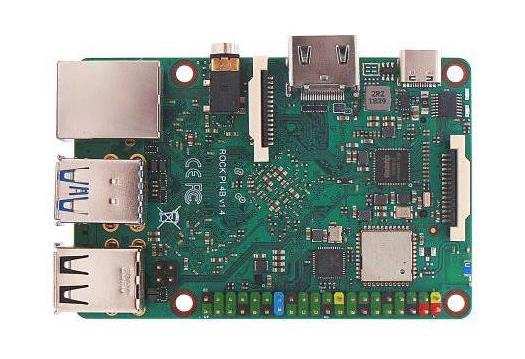
If you're in need of a powerful SBC on a budget, the Rock Pi 4 is an excellent option. In its Raspberry Pi 4 footprint, the Rock Pi 4 packs a robust hexa-core ARM Cortex Rk3399 SoC and LPDDR4 RAM. There's a microSD card slot as well as an eMMC module slot. For the Rock Pi 4C, Raxda added an M.2 SSD connector and mini DisplayPort output capable of churning out buttery-smooth 4K@60 visuals. At around $100, the Rock Pi 4C boasts great bang for your buck. A solid budget-conscious but powerful dev board, the Rock Pi 4C is one of the best Raspberry Pi 4 alternatives available.
Pros:
- Dedicated AI stack complete with GPU acceleration
- Great OS support - Linux and Android
- Faster CPU and GPU than the RasPi 4
Cons:
- More expensive than the Pi 4
Rock Pi 4 specs:
- CPU: Rockchip RK3399 dual Cortex-A72, @ 1.8Ghz, quad-core Cortex-A53 @ 1.4Ghz
- GPU: Mali T860MP4 GPU with support for OpenGL ES 1.1 /2.0 /3.0 /3.1 /3.2, Vulkan 1.0, Open CL 1.1 1.2, DX11
- 1GB, 2GB, or 4GB of 64-bit dual-channel LPDDR4 RAM
- 40-pin GPIUO header
- eMMC module
- M.2 SSD connector
- HDMI 2.0 up to 4K@60
- MIPI DSI
- 2.5mm jack
- MIPI CSI
- 802.11 ac Wi-Fi, Bluetooth 5.0
- USB 3.0 with OTG, USB 2.0
- Gigabit LAN
Best Budget-friendly AI-capable Maker Board - Coral Dev Board
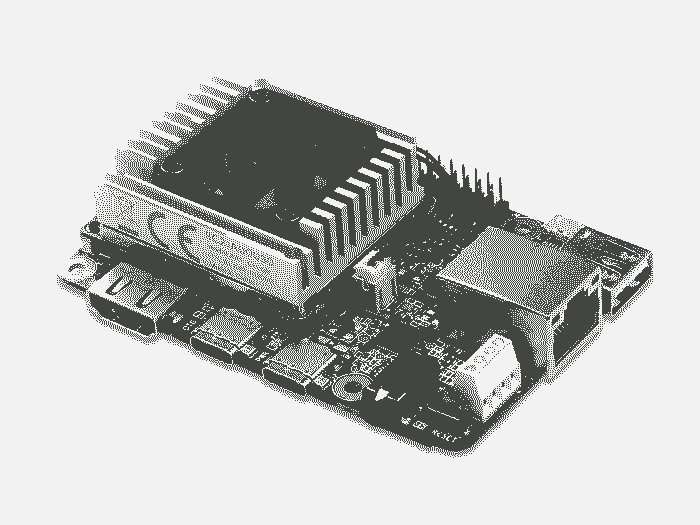
Many artificial intelligence-ready dev boards come with high price tags. Although it's not as cheap as devices such as the RasPi, the Google Coral Dev Board is a good AI-capable, powerful edge computing SBC. For machine learning on the cheap, the Coral Dev Board gives the Raspberry Pi a run for its money. It's a mini PC engineered with machine learning in mind, and one of the best SBCs for AI making.
Pros:
- On-device machine learning with Edge TPU
- Powerful quad-core Cortex A-53 SoC
- 1GB DDR4
- Great for TensorFlow Lite use and machine learning
Cons:
- Expensive
- Not suitable for desktop use
Google Coral Dev Board specs:
- CPU: NXP i.MX 8M SOC (quad Cortex-A53, Cortex-M4F)
- GPU: Integrated GC7000 Lite Graphics
- Onboard Google Edge TPU
- 1GB LPDDR4
Best Powerful Single Board Computer for Deep Learning - Rock Pi N10
Packing an up-for-anything Rockchip RK3399Pro, the Rock Pi N10 includes a neural processing unit (NPU) specifically designed for deep learning and other artificial intelligence applications. The Rock Pi N10 is a great single-board computer for AI, and doesn't break the bank despite its exceptional processing power. Able to run Tensor Flow, Android, and Linux distros, it's a nifty dev board that handles machine learning on a modest budget.
Pros:
- Dedicated NPU with 3.0 TOPS
- Up to 8GB of DDR3
- Powerful RK3399Pro and Mali T860MP4
- 16GB of eMMC
- M.2 SSD connector
- Full-size HDMI with 4K@60 support
Cons:
- Only DDR3, not DDR4
- No built-in Wi-Fi or Bluetooth
Rock Pi N10 specs:
- CPU: RK3399Pro dual Cortex-A72, frequency 1.8GHz with quad Cortex-A53, frequency 1.4GHz
- GPU: Mali T860MP4 GPU, OpenGL ES 1.1 /2.0 /3.0 /3.1 /3.2, Vulkan 1.0, Open CL 1.1 1.2, DX1\
- NPU with 3.0 TOPS of compute power
- Up to 8GB of 64-bit dual-channel LPDDR3@1866Mb/s, 3GB for CPU/GPU, 1GB for NPU
- 16GB eMMC module, microSD card slot, M.2 SSD connector
- FUll-size HDMI 2.0 with 4K@60 support
- MIPI DSI 2-lane connector
- 3.5mm audio jack
- MIPI CSI 2-lane connector
- 1 x USB 3.0 OTG, 2 x USB 2.0
- Gigabit LAN Ethernet port, optional Wi-Fi and Bluetooth module
- 40-pin GPIO header
Most Powerful Single-Board Under $100 - RockPro64
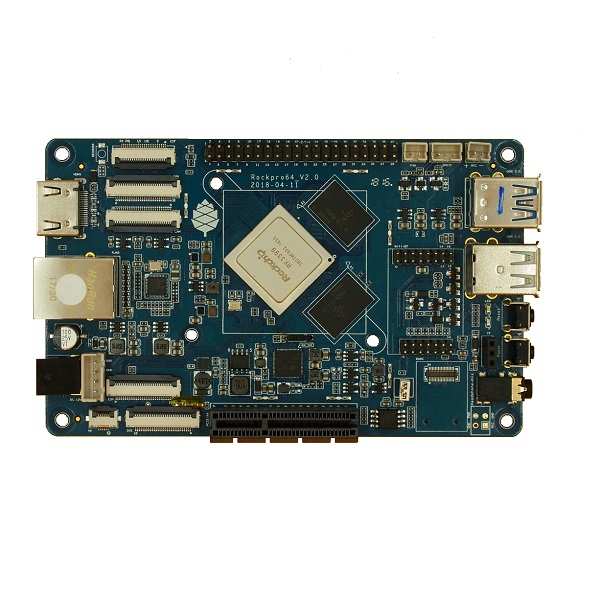
With its Rockchip Rk3399 SoC, Mali T-860 GPU, and up to 4GB of LPDDR4 RAM, the RockPro64 is a fantastic and ultra-powerful single-board computer. At under $100, it's got a great price-to-performance ratio. Retro gaming, basic desktop functionality, and even network-attached storage (NAS) uses are all possible. It's the most powerful single board that Pine64 offers, and a solid pick up for a variety of maker applications.
Pros:
- Great for gaming
- Powerful CPU and GPU combo
- DDR4 RAM up to 4GB
- 40-pin GPIO header
- PCIe x4 slot
- Gigabit Ethernet
- eMMC and microSD
Cons:
- No Bluetooth or Wi-Fi - available separate module
RockPro64 specs:
- CPU: Rockchip RK3399 Hexa-Core (dual ARM Cortex A72 and quad ARM Cortex A53) 64-Bit Processor and CPU: Mali T860MP4 Quad-Core GPU
- 2GB or 4GB LPDDR4 RAM
- PCIe x4 open-ended slot
- eMMCmodule and microSD card slot
- 1 x USB 3.0Type-C Host with DisplayPort 1.2, 1 x USB 3.0 type A host, 2 x USB 2.0 Host
- Gigabit Ethernet
- PI-2 GPIO Bus
- 1 x HDMI 2.0 port
- MIPI DSI interface, eDP and Touch Panel interfaces, stereo MIPI CSI interface
Best Cheap Powerful Maker Board Under $50 - Raspberry Pi 4
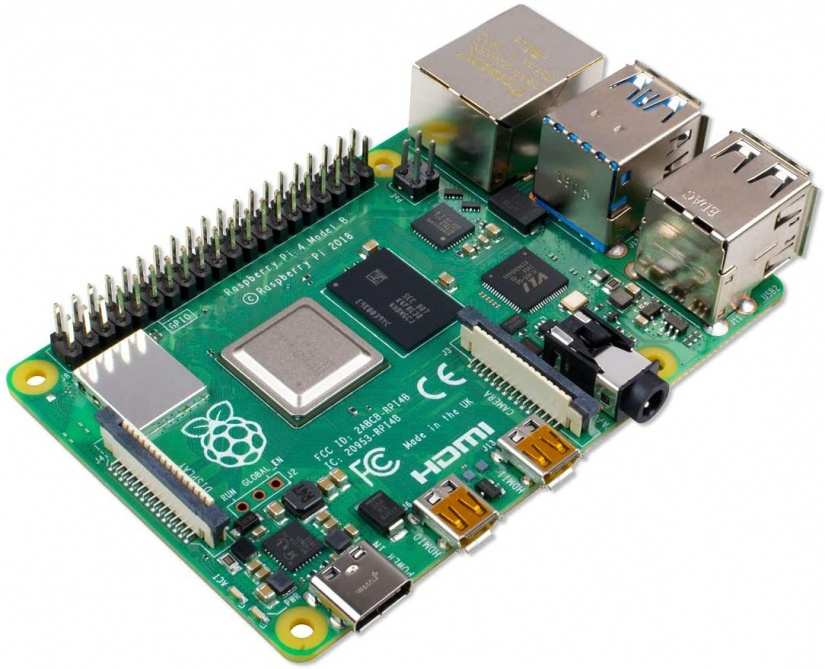
If you've got a shoestring budget, the Raspberry Pi 4 is a superb pick. Admittedly, it's not the beefiest of computers. Nevertheless, the RasPi 4 is arguably the best single-board computer for most people. It's affordable and packs a performance punch particularly for the price point. Sure, far more capable SBCs exist, but for three or more times the cost of the Pi 4. As such, if you require modest processing power, the Pi 4 is the right RasPi model for you. Pairing the Pi with the TensorFlow Lite, you can add the USB Accelerator for TensorFlow, transforming it into an AI-capable device. Likewise, the Google AIY Kit enables artificial intelligence do-it-yourselfing with the Pi. Striking an excellent mix of affordability and power, the Raspberry Pi 4 is the most powerful SBC under $50.
Pros:
- Versatile
- Affordable
- Several different RAM options
- Easy to use
- Excellent price-to-performance ratio
- Small footprint
- Low power draw
- Great OS compatibility - Linux, Android, Chrome OS, non-Linux OSes
Cons:
- Not a true desktop replacement
- More powerful SBCs available
Raspberry Pi 4 specs:
- Broadcom BCM2711, Quad-core Cortex-A72 (ARM v8) 64-bit SoC @ 1.5GHz
- 1GB, 2GB, 4GB, or 8GB LPDDR4-2400 SDRAM (depending on model)
- 2.4 GHz and 5.0 GHz IEEE 802.11ac wireless, Bluetooth 5.0, BLE
- Gigabit Ethernet
- 2 USB 3.0 ports; 2 USB 2.0 ports.
- Raspberry Pi standard 40 pin GPIO header (fully backwards compatible with previous boards)
- 2 × micro-HDMI ports (up to 4kp60 supported)
- 2-lane MIPI DSI display port
- 2-lane MIPI CSI camera port
- 4-pole stereo audio and composite video port
- H.265 (4kp60 decode), H264 (1080p60 decode, 1080p30 encode)
- OpenGL ES 3.0 graphics
- MicroSD card slot for loading operating system and data storage
- 5V DC via USB-C connector (minimum 3A*)
- 5V DC via GPIO header (minimum 3A*)
- Power over Ethernet (PoE) enabled (requires separate PoE HAT)
- Operating temperature: 0 – 50 degrees C ambient
The Most Powerful Single Board Computers for All Budgets - Final Thoughts
You'll find a veritable treasure trove of SBCs for a variety of uses. Whereas some like the Pi Zero and Zero W are low-cost, energy-efficient single-board computers, others pack a performance punch. If you want the most powerful SBC available, look to the likes of the UDOO Bolt V8, Nvidia Jetson NX and Nano, as well as the Odyssey X86J4105. For artificial intelligence, the Jetson is a solid choice, or the Google Coral Dev Board, Rock Pi 4C, and Rock Pi N10 are contenders. At the low end, the Raspberry Pi 4 is admittedly underpowered compared to the likes of the Udoo Bolt and Nvidia Jetson, but for the price it's a great buy. And the RockPro64 offers good bang for your buck.
Your turn: Which powerful SBCs do YOU recommend?


































